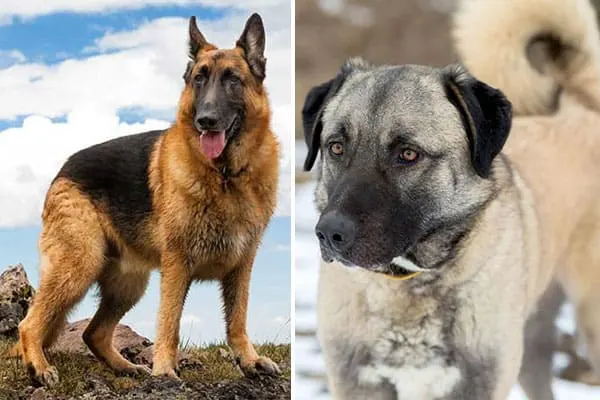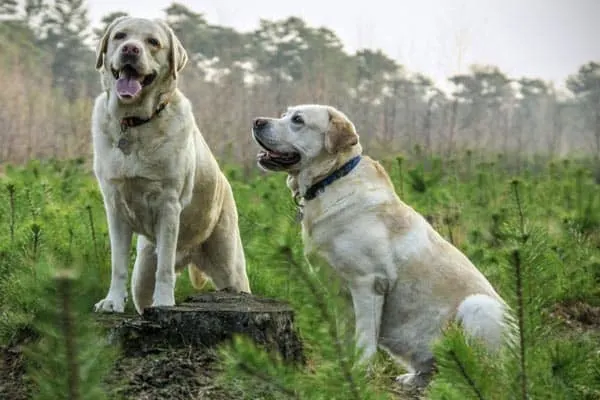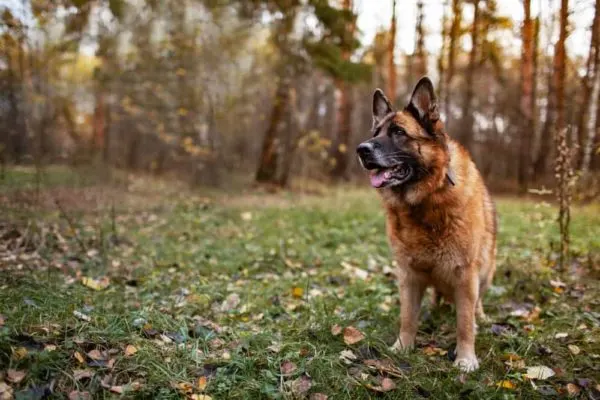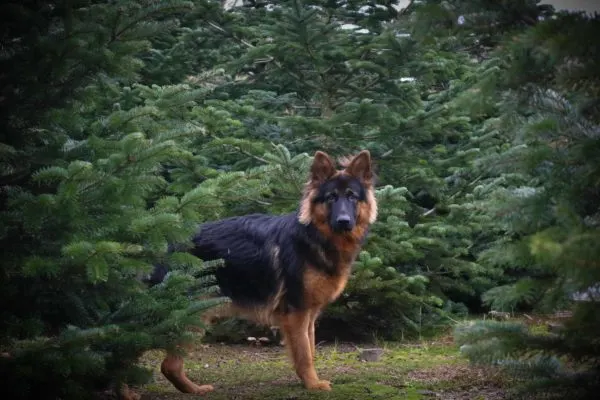German Anatolian Shepherd: The Working Dog With A Powerful Bite
The German Shepherd Anatolian Shepherd mix is not common, but she is a designer dog nonetheless.
Although the date of the first deliberate attempt to combine the two working dogs is unknown, the likely desire was a dog proficient in herding and guard duty.
I thought a Kangal must be an exotic wild canid only to find out is was the Anatolian Shepherd, a domesticated dog breed that has the 9th hardest bite force among animals on earth!
If the Kangal was the stuff of mythical folklore, the German Shepherd was the tried and true classic. German Shepherds are everywhere and even seemingly timeless on television.
Yet, German Shepherds are often as misunderstood as the less familiar Anatolian Shepherd.

Where Did Your Anatolian Shepherd German Shepherd Mix Originate?
German Anatolian Shepherds are large dogs with an independent streak and exceptional athleticism. Most registries group Kangals and Anatolian Shepherds under the same breed umbrella.
No one would know for sure if the original breeders of the Anatolian German Shepherd sought a more independent herding dog for their flocks or a more trainable family pet.
However, Anatolians Shepherds rose in demand with the enactment of the Endangered Species Act that suspended killing wolves and cougars that might threaten livestock.
As Anatolian Shepherds grew more commonplace, it was probably only a matter of time before ranchers thought to outcross them with German Shepherds to create more manageable pets.
Utilizing different breeds
Similarly, shepherds using Alsatians could have infused Anatolian bloodlines to create a more formidable adversary against predators.
German Shepherds trace their ancestors to two foundation sires, Hektor and his son Beowulf, and three major regions of Germany.
Although probably around as a distinct type since the seventh century, the first-named German Shepherd Dog was Hektor in 1899. He later became Horand von Grafrath.
Strict guidelines under Max von Stephanitz dictated careful linebreeding and extensive culling to lead to one of the most versatile and valued of all working dogs.
Von Stephanitz marketed the GSD to the police force, and the dog’s success there expanded into the military and post World War I into guide work for the blind.
German Shepherds inspired their own working evaluation, known as Schutzhund, which is now the gold standard for quality obedience and skills in other breeds as well.

Versatile working dogs
German Shepherds excel in agility, search and rescue, narcotics and bomb detection, and physical assistance work.
While the Shepherd is a relatively modern breed, the Anatolian Shepherd is ancient. Fossil remnants place large molosser-type dogs with livestock civilizations as early as 2,000 B.C.
They descended from hunting dogs of a huge area called Mesopotamia, much of what is now Iraq and Kuwait, as well as a broad region around the Turkey-Syrian border and Southeastern Turkey.
Historians believe Anatolia is the location most responsible for developing the breed into a fierce protector of sheep for nomadic herders.
The Anatolian Plateau encompasses much of the vast peninsula of Turkey and is remarkable for its hot, dry summers and harsh frigid winters.
The Anatolian Shepherd came to the U.S. in the 1930s as an experiment to determine the best herding dog. The experiment failed because the Kangals overate, and the donated pair produced 12 puppies during wartime rations on food.
The Anatolians made a more successful arrival in the 1950s, took root as livestock guardians in the United States in the 1970s, and joined the AKC in 1999. They remain great livestock protectors in many countries and have found use in the Cheetah conservation efforts.
Do Not Expect A Very Playful Dog
Not many would question the dedication to duty of the GSD working lines. German Shepherds have an uncommon ability to focus on a single task regardless of outside distractions, and Anatolian Shepherd Dogs are very serious as adults.
However, the Anatolian Shepherd is no slacker either, not even given to games of fetch. Alaskan Husky owners attribute much of the work ethic their dogs display to previous outcrosses with Anatolian Shepherds.
What does the German Anatolian Shepherd Look Like?
German Anatolian Shepherds are large dogs, 26 to 30 inches tall, and weighing 90 to 125 pounds. Your puppy will most often be the common fawn color of the Anatolian with a black facial mask and the stereotypical white blaze that splits the face. Hybrids can also be white, brindle, red, or gray.
Your German Anatolian will be physically impressive, giving you a sense of power and athleticism.

How Will Your German Anatolian Shepherd Be With Children and Other Animals?
Experts remind you often that herding is a modification of a dog’s prey drive. What you will see in dogs such as Border Collies and German Shepherds is strengthening their instincts of pursuit.
Therefore, you often must educate German Shepherds on who their flock involves. They protect those who belong to the flock and guard against strangers who do not.
Depending on the dog, a German Shepherd may be openly hostile to unfamiliar people, animals, and children. A poorly-socialized GSD can be aggressive and bite without discrimination or be timid and fearful.
Ideal German Shepherds are wary of strangers but polite with people you accept. Even in the show ring, judges allow a certain degree of aloofness but no aggression or belligerence and certainly no cowering. In working dogs, you will especially notice the German Shepherd’s boldness and fearlessness.
The Anatolian Shepherd is another fearless dog but not a herding breed. Anatolian Shepherds may have originated from hunting dogs, but like Great Danes have lost a lot of their prey drive through evolutionary use.
The use of intimidation when guarding
Developed for protecting livestock against predators and thieves, Anatolian Shepherds use a lot of body language in carrying out their duties.
An Anatolian Shepherd Dog’s aggressive stance that escalates to vocalization before an attack usually avoids physical injury to themselves, the livestock, and predators.
Programs across the globe from Australia to Africa to North America have been able to utilize Anatolian Shepherds to blend livestock welfare and conservation efforts.
However, the Anatolian can carry out protective measures if necessary. They are speedy, agile, and powerful
Your hybrid will most likely show reserve towards strangers but be accepting of everyone, including animals, who live in your house and on your property.
Anatolian Shepherds guard alpacas and chickens as easily as sheep and cattle, so expect your horses and everything else to be well protected. Socialization is paramount, as for any dog, or your mix could be uncontrollably aggressive and destructive.
Are Anatolian German Shepherds Dangerous?
Anyone familiar with dogs knows any of them can be dangerous under certain conditions, regardless of what the media portrays.
However, the reality is that certain breeds cause much more damage than others because of their power, size, and sometimes backgrounds.
German Shepherds have a natural guarding instinct that, if combined with irresponsible training and poor breeding, can lead to serious bites and fatalities.
Although far behind Pit Bulls as dogs most likely to bite and cause catastrophic injury, the German Shepherd’s high ranking as a dangerous dog is concerning.
Some locales have become motivated to ban owning German Shepherds, and insurance companies often also show prejudice against them.
Anatolian Shepherds are usually protective without being aggressive. They can develop friendships with people in your social circle, but you cannot rush them.

These Shepherds tend to be independent minded
Moreover, Anatolian Shepherds determine who they like independently, and similarly to the Kuvasz, may never change their minds. Nevertheless, Kangals are steady-tempered and require a lot of provocation to bite.
If you socialize your Anatolian German Shepherd, he will be slow to bite but probably not the warmest dog at his first meeting with an unfamiliar face.
After all, is said and done, both Anatolian Shepherds and German Shepherds appear on various dangerous dogs lists that may restrict ownership and public exposure, and some places outright ban them.
Bans usually are sure to list dogs under all their common names and specify that restrictions apply to all mixes involving the mentioned breeds.
If you decide an Anatolian Shepherd German Shepherd mix is right for you, perform your due diligence and make sure your place of residence allows the dog with no restriction.
With an ever-expanding list of objectionable dog breeds, you can safely assume a large dog will be on most prohibited policies for property rentals and insurance writers. Some will take into account your dog’s personality, but many will not.
Overwhelmingly, dogs like German Shepherds and Kangals earn a bad reputation by landing in the wrong hands of people inexperienced in dog training, unsure around forceful animals, or unknowledgeable about the breeds they have.
The Fascinating Facts About Bite Force
Bite force, the amount of pressure applied per square inch from the power of the jaws, has been grossly exaggerated for many dog breeds, namely the Pit Bull. Proclaimed to have jaws like a steel trap, Pit Bulls, in reality, do not have the strongest bite force, nor do they lock their jaws during and attack.
Pit Bulls are only relevant here as a comparison tool. We talked briefly about the bite force of the Kangal, and here is a list of some of the fascinating animals mentioned earlier.
- Saltwater Crocodile – 7,000 PSI+
- Hippo – 1,800 PSI
- Wolf – 1,200 PSI
- Hyena – 1,100 PSI
- Tiger – 1,050 PSI
- Grizzly Bear – 975 PSI
- Kangal – 743 PSI
- Lion – 650 PSI
- German Shepherd – 238 PSI
- Pit Bull – 235 PSI
Your hybrid will likely have the bite force of a mastiff at around 520 PSI.
Do Anatolian German Shepherds Make Good Pets?
For the majority of dog owners, the GSD Anatolian Shepherd hybrid will not be an ideal pet. Many of the traits that make her parents’ great dogs are not manageable qualities for the typical family.
Protective
Some dogs may become overly protective and possessive and display aggression as a result.
Aggressive
Occasionally, a hybrid could display dangerous aggression against a perceived threat. Anatolian Shepherds are difficult to call off an attack once they become engaged, so if your mix inherits more of this gene, you may have a liability.
Large dogs
Even if your dog is gentle, the public often has a fear of big dogs.
Work ethic
Your mixed dog is likely to have both parents of a working family line. German Shepherd and Anatolian Shepherd working lines are not happy unless they have jobs. Games will not cut it for a Kangal, so finding a task mentally-stimulating enough could present a real problem. Your hybrid will be a working dog.
Exercise
While one source said Kangals did not need much exercise, the dog’s ancestry belies that. Anatolian Shepherds may not have spent hours trotting across the plains, but they were constantly vigil in harsh climates, a very consuming feat. They also covered miles of travel over days as shepherds moved their flocks. You will need to provide mental stimulation and physical exercise for your Anatolian German Shepherd.
Escape artist
Anatolian Shepherds were developed to be independent thinkers and do not do well with the combination of confinement and no job. Your Shepherd mix may be intent on getting out of the yard every chance he gets, and you can imagine the havoc such a large dog running amok would cause among your neighbors.
Difficulty training
As mentioned multiple times, Anatolian Shepherds are independent, but they can also be dominant and stubborn. German Shepherds are large and sometimes have problems with dominance aggression. A German Shepherd Kangal mix requires an experienced and firm owner. If you are a novice, hire a professional trainer to help you work effectively with your dog.
What Are Health and Longevity Like?
German Shepherds can live 9 to 12 years. Anatolian Shepherds live 13 to 15 years, longer than most dogs their size. According to Doggiedesigner.com, German Anatolian Shepherds live 10 to 13 years.
German Shepherd Anatolian Shepherd mixes are relatively healthy. They can suffer from a few hereditary problems.
Heart Disease
Although Doggiedesigner.com mentions heart disease as a health concern of the German Anatolian Shepherd, both parent breeds have low incidence according to OFA statistics.
However, dilated cardiomyopathy is the most common form of heart disease in large-breed dogs. Vin.com cites that it is rare for a crossbred dog to develop DCM, so this is one case where hybridization creates a potentially healthier dog.
GDV
Gastric dilatation and volvulus are serious conditions that may develop under a variety of circumstances. Often after a large meal, a dog can experience a bloated stomach that then flips. GDV is always a concern in large-breed dogs with a deep chest.
Dysplasia
Hip and elbow dysplasia will be the major concerns for your Shepherd mix.
Hemophilia
Hemophilia is a clotting disorder that causes prolonged bleeding in affected dogs. German Shepherds carry the hemophilia gene.
Degenerative Myelopathy
Both the purebred GSD and Anatolian Shepherd can develop degenerative myelopathy, but the German Shepherd inherits it to a much greater degree. D.M. is a neurological disorder that affects older dogs over seven years and leads to progressive paralysis.
Ehler Danlos Syndrome
A rare inherited disease most common in English Springer Spaniels, you may see Ehler Danlos crop up occasionally in German Anatolian Shepherds. The disease involves a lack of collagen production resulting in fragile skin and joint abnormalities.
Your Anatolian Shepherd German Shepherd Mix Will Be Exceptionally Weather Resistant
German Shepherds and Anatolian Shepherds both have dense double coats that insulate against cold and hot temperatures.
Herders bred Anatolian Shepherds to brave the harshest weather extremes and German Shepherds to withstand the winters in the high plains.
Your German Shepherd Anatolian Shepherd mix will have a medium-length dense double coat that will probably need weekly brushing.
Although made to withstand the heat as well as the cold through efficient air circulation, adaptation is for dry conditions. Do not expect your dog to do well outside if you live in a hot, humid area.
Feed Your German Anatolian Shepherd Sensibly
Neither the GSD nor the Anatolian Shepherd is prone to obesity. Still, overweight issues have become more of a problem with the current breeding programs of German Shepherds and poor exercise habits.
Rough estimates on feeding your mixed dog are four to five cups of high-quality food with animal protein sources as the main ingredients.
You should split your dog’s meals over two or three feedings to minimize bloat concerns. If your dog appears heavy, consult your veterinarian about decreasing caloric intake.
Your German Anatolian Shepherd Will Have High Guarding Potential
The major concern you will have for your Anatolian GSD mix is managing aggression. She will naturally protect and guard your family with no urging or training from you. The less you focus on guard potential, and the more you concentrate on obedience, the better pet you will have.
It is different if your goal is a functioning working dog, but such a canid will require specialized training.
Video of German Shepherd Anatolian Shepherd Mix
Your German Anatolian Shepherd will be a large, striking dog with high agility, athleticism, energy, and protectiveness. Socialization as a young puppy is essential for your dog to be a suitable member of the suburbs, but certain locations may still ban him.
Training is also crucial but far from easy despite your hybrid’s intelligence and steady nature.
This video portrays an Anatolian Shepherd and the way the breed bonds with herd animals. Anatolian Shepherds learn to detect the presence of predators through the body language of their charges because the sheep or goats accept them.
If you wonder why this dog is so playful, he is a puppy indicated by his tiny teeth. However, many videos show a playful side to Anatolian Shepherds that probably disappear when they mature at two or three years of age.
This is the best indication we could find of what an Anatolian GSD Shepherd might look like. You can readily see the Kangal in the coloration.
Note the distinctive barking. That is a vocalization you will need to accustom yourself to, which could escalate to a deep-throated growl and scream.
The German Shepherd is evident in the straighter tails, the narrow impression of the face where it joins the snout, and the semi-prick ears on one of the puppies.






























